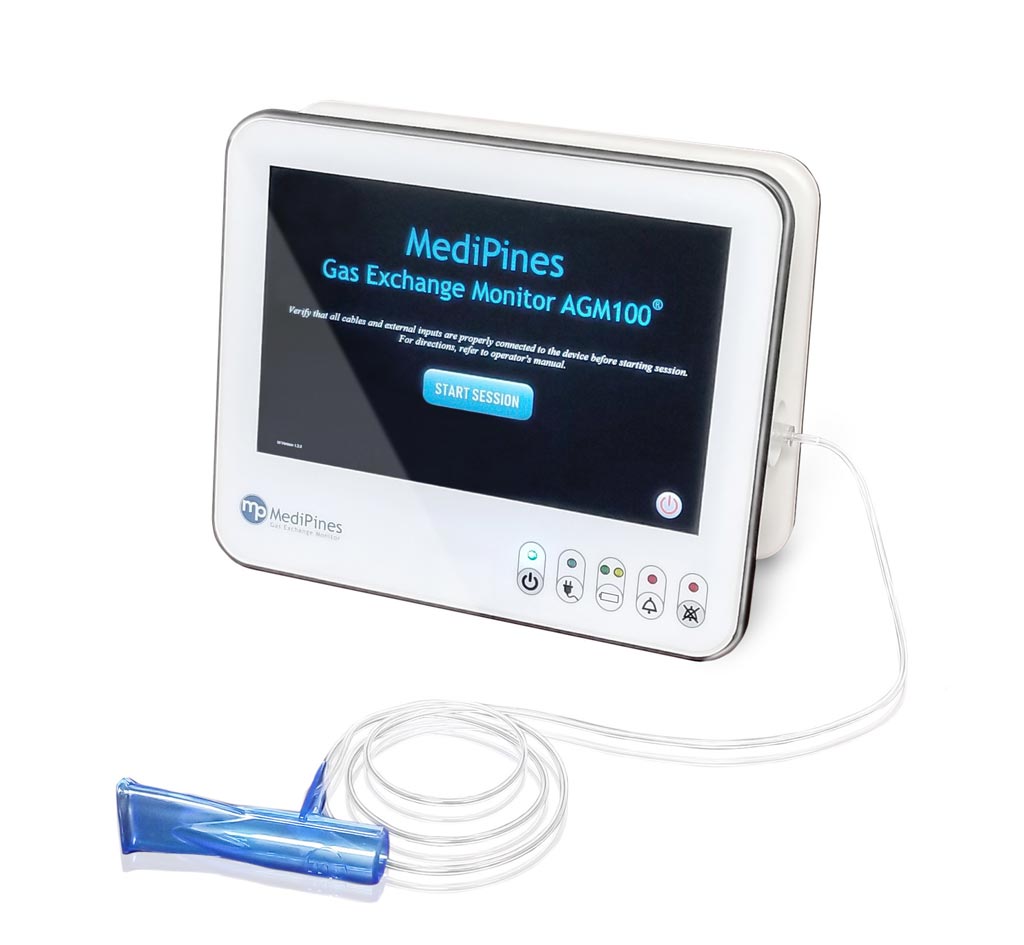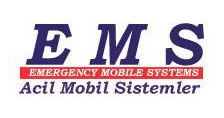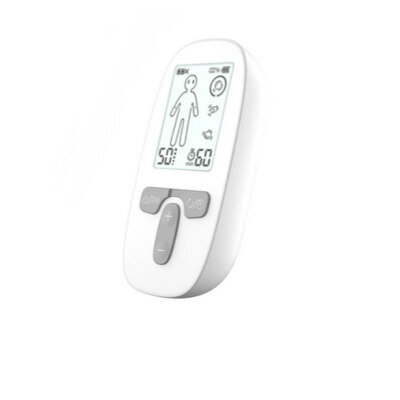Non-Invasive Device Monitors Pulmonary Gas Exchange
|
By HospiMedica International staff writers Posted on 13 Feb 2019 |

Image: The MediPines Gas Exchange Monitor (Photo courtesy of MediPines).
A new patient monitor provides clinicians with real-time pulmonary parameters and insights to support rapid triage and treatment decisions for patients with respiratory conditions.
The MediPines (Orange County, CA, USA) Gas Exchange Monitor is a portable, non-invasive, point-of-care (POC) device that integrates a comprehensive set of critical parameters and innovative respiratory indices (analyzed from a patient’s normal breathing samples) in order to provide non-invasive measurement of respiratory gas exchange and real-time respiratory status detection. The monitor can thus provide clinicians with a range of information on patient gas exchange previously available only through invasive or complicated methods.
Respiratory parameters include functional oxygen saturation (SpO2%); pulse rate; partial pressure of inspired oxygen (PIO2); end-tidal oxygen partial pressure (PETO2); end-tidal carbon dioxide partial pressure (PETCO2); respiratory Rate (RR); calculated arterial partial pressure of oxygen (gPaO2); oxygen deficit – a breath-based index of gas exchange inefficiency; arterial to alveolar partial pressure oxygen exchange ratio (gPaO2/PAO2); the ratio of arterial partial pressure of oxygen to fraction of oxygen inspired (gPaO2/FiO2); and respiratory quotient (RQ), the ratio between the amount of CO2 produced in metabolism and oxygen used.
“This device is a significant step forward in advancing respiratory medicine, providing hospitals with vital respiratory care measurements to aid clinicians in diagnosis and treatment, immediately at the point-of-care,” said Steve Lee, CEO of MediPines. “This is a result of years of scientific and medical research working with the world-renowned respiratory physiology team led by Dr. John B. West, distinguished professor emeritus of medicine and physiology, and author of 25 books and over 500 publications focusing on pulmonary physiology.”
During respiratory distress, SpO2 and vital measures provide some immediate indication of oxygenation status, but neither provides sufficient gas exchange information, necessary to make clinical decisions. Arterial blood gas tests provide useful gas exchange information, but require drawing blood. And while spirometry can provide airflow and lung capacity measurements, it requires training and has poor sick patient compliance. Clinicians are therefore looking for non-invasive alternatives to assessing respiratory status that can guide therapy.
Related Links:
MediPines
The MediPines (Orange County, CA, USA) Gas Exchange Monitor is a portable, non-invasive, point-of-care (POC) device that integrates a comprehensive set of critical parameters and innovative respiratory indices (analyzed from a patient’s normal breathing samples) in order to provide non-invasive measurement of respiratory gas exchange and real-time respiratory status detection. The monitor can thus provide clinicians with a range of information on patient gas exchange previously available only through invasive or complicated methods.
Respiratory parameters include functional oxygen saturation (SpO2%); pulse rate; partial pressure of inspired oxygen (PIO2); end-tidal oxygen partial pressure (PETO2); end-tidal carbon dioxide partial pressure (PETCO2); respiratory Rate (RR); calculated arterial partial pressure of oxygen (gPaO2); oxygen deficit – a breath-based index of gas exchange inefficiency; arterial to alveolar partial pressure oxygen exchange ratio (gPaO2/PAO2); the ratio of arterial partial pressure of oxygen to fraction of oxygen inspired (gPaO2/FiO2); and respiratory quotient (RQ), the ratio between the amount of CO2 produced in metabolism and oxygen used.
“This device is a significant step forward in advancing respiratory medicine, providing hospitals with vital respiratory care measurements to aid clinicians in diagnosis and treatment, immediately at the point-of-care,” said Steve Lee, CEO of MediPines. “This is a result of years of scientific and medical research working with the world-renowned respiratory physiology team led by Dr. John B. West, distinguished professor emeritus of medicine and physiology, and author of 25 books and over 500 publications focusing on pulmonary physiology.”
During respiratory distress, SpO2 and vital measures provide some immediate indication of oxygenation status, but neither provides sufficient gas exchange information, necessary to make clinical decisions. Arterial blood gas tests provide useful gas exchange information, but require drawing blood. And while spirometry can provide airflow and lung capacity measurements, it requires training and has poor sick patient compliance. Clinicians are therefore looking for non-invasive alternatives to assessing respiratory status that can guide therapy.
Related Links:
MediPines
Latest Critical Care News
- 'Universal' Kidney to Match Any Blood Type
- Light-Based Technology to Measure Brain Blood Flow Could Diagnose Stroke and TBI
- AI Heart Attack Risk Assessment Tool Outperforms Existing Methods
- Smartphone Imaging System Enables Early Oral Cancer Detection
- Swallowable Pill-Sized Bioprinter Treats GI Tract Injuries

- Personalized Brain “Pacemakers” Could Help Patients with Hard-To-Treat Epilepsy
- Microscopic DNA Flower Robots to Enable Precision Medicine Delivery
- Origami Robots to Deliver Medicine Less Invasively and More Effectively
- Improved Cough-Detection Technology Aids Health Monitoring
- AI Identifies Children in ER Likely to Develop Sepsis Within 48 Hours
- New Radiofrequency Therapy Slows Glioblastoma Growth
- Battery-Free Wireless Multi-Sensing Platform Revolutionizes Pressure Injury Detection
- Multimodal AI to Revolutionize Cardiovascular Disease Diagnosis and Treatment
- AI System Reveals Hidden Diagnostic Patterns in Electronic Health Records
- Highly Sensitive On-Skin Sensing Monitor Detects Vitamin B6 and Glucose in Sweat
- Artificial Intelligence Revolutionizing Pediatric Anesthesia Management
Channels
Surgical Techniques
view channel
Minimally Invasive Endoscopic Surgery Improves Severe Stroke Outcomes
Intracerebral hemorrhage, a type of stroke caused by bleeding deep within the brain, remains one of the most challenging neurological emergencies to treat. Accounting for about 15% of all strokes, it carries... Read more
Novel Glue Prevents Complications After Breast Cancer Surgery
Seroma and prolonged lymphorrhea are among the most common complications following axillary lymphadenectomy in breast cancer patients. These postoperative issues can delay recovery and postpone the start... Read morePatient Care
view channel
Revolutionary Automatic IV-Line Flushing Device to Enhance Infusion Care
More than 80% of in-hospital patients receive intravenous (IV) therapy. Every dose of IV medicine delivered in a small volume (<250 mL) infusion bag should be followed by subsequent flushing to ensure... Read more
VR Training Tool Combats Contamination of Portable Medical Equipment
Healthcare-associated infections (HAIs) impact one in every 31 patients, cause nearly 100,000 deaths each year, and cost USD 28.4 billion in direct medical expenses. Notably, up to 75% of these infections... Read more
Portable Biosensor Platform to Reduce Hospital-Acquired Infections
Approximately 4 million patients in the European Union acquire healthcare-associated infections (HAIs) or nosocomial infections each year, with around 37,000 deaths directly resulting from these infections,... Read moreFirst-Of-Its-Kind Portable Germicidal Light Technology Disinfects High-Touch Clinical Surfaces in Seconds
Reducing healthcare-acquired infections (HAIs) remains a pressing issue within global healthcare systems. In the United States alone, 1.7 million patients contract HAIs annually, leading to approximately... Read moreHealth IT
view channel
Printable Molecule-Selective Nanoparticles Enable Mass Production of Wearable Biosensors
The future of medicine is likely to focus on the personalization of healthcare—understanding exactly what an individual requires and delivering the appropriate combination of nutrients, metabolites, and... Read moreBusiness
view channel
Philips and Masimo Partner to Advance Patient Monitoring Measurement Technologies
Royal Philips (Amsterdam, Netherlands) and Masimo (Irvine, California, USA) have renewed their multi-year strategic collaboration, combining Philips’ expertise in patient monitoring with Masimo’s noninvasive... Read more
B. Braun Acquires Digital Microsurgery Company True Digital Surgery
The high-end microsurgery market in neurosurgery, spine, and ENT is undergoing a significant transformation. Traditional analog microscopes are giving way to digital exoscopes, which provide improved visualization,... Read more
CMEF 2025 to Promote Holistic and High-Quality Development of Medical and Health Industry
The 92nd China International Medical Equipment Fair (CMEF 2025) Autumn Exhibition is scheduled to be held from September 26 to 29 at the China Import and Export Fair Complex (Canton Fair Complex) in Guangzhou.... Read more







.jpg)






